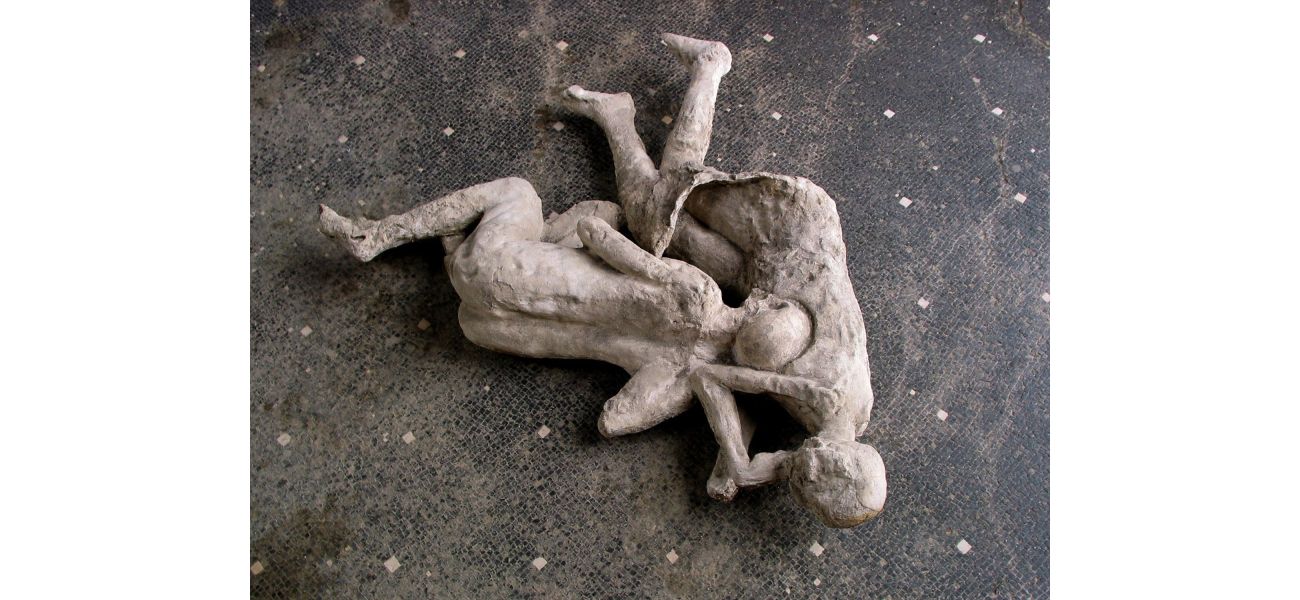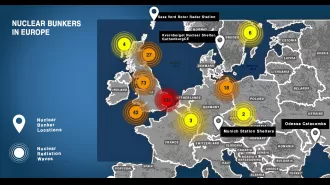New DNA evidence challenges previous beliefs on how people died in Pompeii.
DNA from Pompeii reveals unexpected identities of victims.
November 8th 2024.

Ancient DNA has shed light on the identities of people who were tragically killed during the eruption of Mount Vesuvius in the ancient Roman town of Pompeii. This groundbreaking discovery has overturned previously held beliefs about the genetic relationships, ancestry, and even the gender of those who perished in the disaster. The eruption, which occurred in AD 79, unleashed deadly gases and ash that slowly engulfed the city and its inhabitants, preserving their final moments like a haunting time capsule.
The first attempts to unearth the lost city of Pompeii began in 1748, but it wasn't until 1863 that archaeologist Giuseppe Fiorelli developed a method for creating plaster casts of the victims. These casts were made by pouring liquid chalk into the outlines left behind by the decomposed bodies, preserving the shapes of 104 individuals. Over time, narratives were formed based on the positioning of the remains, such as an adult wearing a bracelet holding a child and believed to be the child's mother, or a group of bodies found together that were thought to be sisters.
However, during modern restoration efforts, researchers were able to extract DNA from bone fragments found within the plaster casts, revealing that these assumptions were not accurate. The new findings, published in the journal Current Biology, have challenged researchers' understanding of the population demographics and familial relationships in Pompeii.
According to coauthor David Reich, a professor of genetics at Harvard Medical School and Harvard University, the scientific data does not always align with common assumptions. This discovery has opened up new insights into the past and has the potential to change our understanding of gender and family dynamics in ancient civilizations.
The preservation of Pompeii's tragic scenes has provided archaeologists with a remarkable window into the past, allowing them to understand what life was like during the Roman Empire. Located in Italy's Campania region, Pompeii was a Roman colony with a thriving port, making it a desirable location for settlement. Despite attempts by other civilizations to conquer it, Pompeii remained a Roman stronghold until it was wiped out by the eruption of Mount Vesuvius.
The ash and volcanic rock that covered the city also preserved the bodies of its inhabitants, as well as buildings, monuments, and other artifacts. When excavations began, archaeologists uncovered nearly 1,000 outlines of people, both isolated and grouped together, in various locations throughout the city.
In 2015, the Archaeological Park of Pompeii began restoring 86 of the original 104 plaster casts. During this process, x-rays and CT scans revealed bone fragments within the casts, indicating that the bodies had been manipulated and altered during the initial casting process. The study team, which included park scientists and anthropologists, was invited to research these fragments and collaborate on a larger project to better understand the genetics of the population in ancient Pompeii.
Despite the delicate and fragmented nature of the bones, the team was able to extract and analyze DNA from multiple fragments found in different locations within the park. This included remains found at the House of the Golden Bracelet, the House of the Cryptoporticus, and the Villa of the Mysteries. The House of the Golden Bracelet, named after an adult found wearing a golden bracelet with a child on their hip, was believed to be a family unit consisting of a mother, father, and two children. However, the DNA analysis revealed that this was not the case, and the individuals were not related as previously thought.
This ground-breaking research has challenged long-held assumptions about the victims of Mount Vesuvius' eruption and provided a unique glimpse into the genetic diversity of an ancient Roman city. As coauthor David Caramelli stated, this discovery is like a "genetic photo" taken of Pompeii 2,000 years ago, and it has the potential to change our understanding of this tragic event and the lives of those who were lost.
When Mount Vesuvius erupted in 79 AD, it was a tragedy that forever changed the ancient Roman town of Pompeii. The volcano unleashed deadly gases and ash that slowly killed most of the city's population, leaving behind a scene of destruction preserved for centuries. The first excavations of Pompeii began in 1748, but it wasn't until 1863 that archaeologist Giuseppe Fiorelli developed a method to make plaster casts of some of the victims, capturing their final moments in a eerie time capsule.
These plaster casts have provided a unique window into the past, giving archaeologists a glimpse into the lives of the people who once lived in Pompeii during the height of the Roman Empire. However, as modern efforts to restore the casts began, researchers made a surprising discovery. DNA analysis of bone fragments found within the casts revealed that some assumptions about the victims were incorrect.
For example, one cast was thought to be a mother holding her child, but DNA analysis showed that the adult and child were not related. Similarly, a group of bodies found together were assumed to be sisters, but DNA analysis proved otherwise. These findings, published in a new study in the journal Current Biology, challenge traditional assumptions about gender and familial relationships in Pompeii.
The city of Pompeii, located about 22.5 kilometers southeast of Naples, was a thriving port during the Roman Empire. Despite attempts by the Greeks, Etruscans, and Samnites to conquer it, Pompeii became a Roman colony. But in 79 AD, Mount Vesuvius erupted, burying the city and its inhabitants in ash and volcanic rock. The ash preserved the bodies of people and animals, as well as buildings, monuments, and other artifacts, providing a unique snapshot of life in ancient Pompeii.
When excavations began in the 18th century, nearly 1000 casts were found, both isolated and grouped together in various locations throughout the city. In 2015, efforts to restore some of the casts began, and X-rays and CT scans revealed that many of them contained bone fragments. The study team, working with the Archaeological Park of Pompeii, was able to extract and analyze DNA from these fragments, providing valuable insights into the genetic diversity of the city's population.
This research is part of a larger project to better understand the genetic makeup of Pompeii during the Roman Empire. According to study coauthor David Caramelli, the study provides a "genetic photo" of the city from 2000 years ago. The team studied remains found at different sites within the archaeological park, including the House of the Golden Bracelet, the House of the Cryptoporticus, and the Villa of the Mysteries. Interestingly, the DNA analysis revealed that some of the assumptions made about the victims based on their positioning in the casts were incorrect.
For example, one cast found in the House of the Golden Bracelet was thought to be a family of four, with an adult wearing a bracelet and a child on their hip, presumed to be the mother. However, DNA analysis showed that the adult and child were not related, and the presumed father was actually found a few meters away. These surprising revelations challenge our understanding of the population demographics and familial relationships in ancient Pompeii, providing a new perspective on this historic tragedy.
The first attempts to unearth the lost city of Pompeii began in 1748, but it wasn't until 1863 that archaeologist Giuseppe Fiorelli developed a method for creating plaster casts of the victims. These casts were made by pouring liquid chalk into the outlines left behind by the decomposed bodies, preserving the shapes of 104 individuals. Over time, narratives were formed based on the positioning of the remains, such as an adult wearing a bracelet holding a child and believed to be the child's mother, or a group of bodies found together that were thought to be sisters.
However, during modern restoration efforts, researchers were able to extract DNA from bone fragments found within the plaster casts, revealing that these assumptions were not accurate. The new findings, published in the journal Current Biology, have challenged researchers' understanding of the population demographics and familial relationships in Pompeii.
According to coauthor David Reich, a professor of genetics at Harvard Medical School and Harvard University, the scientific data does not always align with common assumptions. This discovery has opened up new insights into the past and has the potential to change our understanding of gender and family dynamics in ancient civilizations.
The preservation of Pompeii's tragic scenes has provided archaeologists with a remarkable window into the past, allowing them to understand what life was like during the Roman Empire. Located in Italy's Campania region, Pompeii was a Roman colony with a thriving port, making it a desirable location for settlement. Despite attempts by other civilizations to conquer it, Pompeii remained a Roman stronghold until it was wiped out by the eruption of Mount Vesuvius.
The ash and volcanic rock that covered the city also preserved the bodies of its inhabitants, as well as buildings, monuments, and other artifacts. When excavations began, archaeologists uncovered nearly 1,000 outlines of people, both isolated and grouped together, in various locations throughout the city.
In 2015, the Archaeological Park of Pompeii began restoring 86 of the original 104 plaster casts. During this process, x-rays and CT scans revealed bone fragments within the casts, indicating that the bodies had been manipulated and altered during the initial casting process. The study team, which included park scientists and anthropologists, was invited to research these fragments and collaborate on a larger project to better understand the genetics of the population in ancient Pompeii.
Despite the delicate and fragmented nature of the bones, the team was able to extract and analyze DNA from multiple fragments found in different locations within the park. This included remains found at the House of the Golden Bracelet, the House of the Cryptoporticus, and the Villa of the Mysteries. The House of the Golden Bracelet, named after an adult found wearing a golden bracelet with a child on their hip, was believed to be a family unit consisting of a mother, father, and two children. However, the DNA analysis revealed that this was not the case, and the individuals were not related as previously thought.
This ground-breaking research has challenged long-held assumptions about the victims of Mount Vesuvius' eruption and provided a unique glimpse into the genetic diversity of an ancient Roman city. As coauthor David Caramelli stated, this discovery is like a "genetic photo" taken of Pompeii 2,000 years ago, and it has the potential to change our understanding of this tragic event and the lives of those who were lost.
When Mount Vesuvius erupted in 79 AD, it was a tragedy that forever changed the ancient Roman town of Pompeii. The volcano unleashed deadly gases and ash that slowly killed most of the city's population, leaving behind a scene of destruction preserved for centuries. The first excavations of Pompeii began in 1748, but it wasn't until 1863 that archaeologist Giuseppe Fiorelli developed a method to make plaster casts of some of the victims, capturing their final moments in a eerie time capsule.
These plaster casts have provided a unique window into the past, giving archaeologists a glimpse into the lives of the people who once lived in Pompeii during the height of the Roman Empire. However, as modern efforts to restore the casts began, researchers made a surprising discovery. DNA analysis of bone fragments found within the casts revealed that some assumptions about the victims were incorrect.
For example, one cast was thought to be a mother holding her child, but DNA analysis showed that the adult and child were not related. Similarly, a group of bodies found together were assumed to be sisters, but DNA analysis proved otherwise. These findings, published in a new study in the journal Current Biology, challenge traditional assumptions about gender and familial relationships in Pompeii.
The city of Pompeii, located about 22.5 kilometers southeast of Naples, was a thriving port during the Roman Empire. Despite attempts by the Greeks, Etruscans, and Samnites to conquer it, Pompeii became a Roman colony. But in 79 AD, Mount Vesuvius erupted, burying the city and its inhabitants in ash and volcanic rock. The ash preserved the bodies of people and animals, as well as buildings, monuments, and other artifacts, providing a unique snapshot of life in ancient Pompeii.
When excavations began in the 18th century, nearly 1000 casts were found, both isolated and grouped together in various locations throughout the city. In 2015, efforts to restore some of the casts began, and X-rays and CT scans revealed that many of them contained bone fragments. The study team, working with the Archaeological Park of Pompeii, was able to extract and analyze DNA from these fragments, providing valuable insights into the genetic diversity of the city's population.
This research is part of a larger project to better understand the genetic makeup of Pompeii during the Roman Empire. According to study coauthor David Caramelli, the study provides a "genetic photo" of the city from 2000 years ago. The team studied remains found at different sites within the archaeological park, including the House of the Golden Bracelet, the House of the Cryptoporticus, and the Villa of the Mysteries. Interestingly, the DNA analysis revealed that some of the assumptions made about the victims based on their positioning in the casts were incorrect.
For example, one cast found in the House of the Golden Bracelet was thought to be a family of four, with an adult wearing a bracelet and a child on their hip, presumed to be the mother. However, DNA analysis showed that the adult and child were not related, and the presumed father was actually found a few meters away. These surprising revelations challenge our understanding of the population demographics and familial relationships in ancient Pompeii, providing a new perspective on this historic tragedy.
[This article has been trending online recently and has been generated with AI. Your feed is customized.]
[Generative AI is experimental.]
0
0
Submit Comment





